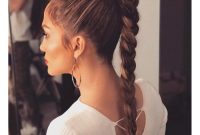In the realm of hair care, the quest for sleek, straight locks has led to a plethora of straightening treatments. From chemical transformations to thermal techniques and mechanical methods, the options can be overwhelming. Embark on a journey to unravel the mysteries of hair straightening, exploring the pros and cons of each method, understanding the science behind them, and making informed decisions about permanent straightening.
Dive into the world of hair care and discover the path to achieving your desired tresses.
As you delve into this comprehensive guide, you’ll uncover the intricacies of chemical hair straightening, exploring the processes, types, and results. Thermal straightening techniques will be demystified, revealing the secrets of heat tools and how to harness their power safely.
Mechanical straightening methods will be laid bare, showcasing their effectiveness and limitations. Ultimately, you’ll gain the knowledge to make an informed choice about permanent straightening, considering factors like hair health, lifestyle, and personal preferences.
Understanding Hair Straightening Treatments

Embark on a journey to transform your curly or wavy locks into sleek, straight tresses. Explore the diverse world of hair straightening treatments, each offering unique benefits and drawbacks. From chemical processes to thermal and mechanical methods, discover the options that suit your hair type and desired results.
Chemical Straightening Treatments
Chemical straightening treatments, also known as relaxers, permanently alter the structure of your hair. These treatments typically involve the application of a chemical solution that breaks down the disulfide bonds in your hair, allowing it to be reshaped into a straighter form.
- Sodium Hydroxide Relaxers: Commonly used for African-American hair, sodium hydroxide relaxers effectively straighten hair, but can be harsh and cause damage if not applied properly.
- Calcium Hydroxide Relaxers: Gentler than sodium hydroxide relaxers, calcium hydroxide relaxers are suitable for all hair types and provide a more natural-looking result.
- Guanidine Hydroxide Relaxers: Offering long-lasting results, guanidine hydroxide relaxers are effective on coarse, resistant hair, but can be more damaging than other relaxers.
Thermal Straightening Treatments
Thermal straightening treatments use heat to temporarily straighten your hair. These treatments are less damaging than chemical relaxers but may require more frequent touch-ups.
- Flat Ironing: The most common thermal straightening method, flat ironing involves using a heated flat iron to press hair into a straight shape. Results last until the next wash.
- Blow Drying: Blow drying your hair with a round brush can help straighten it, although the results are not as long-lasting as flat ironing.
- Hot Comb: A hot comb combines the principles of flat ironing and blow drying, using a heated comb to straighten hair. It is particularly effective on African-American hair.
Mechanical Straightening Treatments
Mechanical straightening treatments physically manipulate your hair to achieve a straighter appearance.
- Japanese Straightening: This intensive treatment involves applying a chemical solution to the hair, followed by heat and tension to permanently straighten it. Results can last up to six months.
- Brazilian Blowout: A semi-permanent treatment that uses a keratin-based solution to smooth and straighten hair. Results typically last for two to three months.
- Keratin Treatment: Similar to the Brazilian Blowout, a keratin treatment uses a keratin solution to reduce frizz and add shine, resulting in straighter-looking hair. Results last for several weeks.
Chemical Hair Straightening
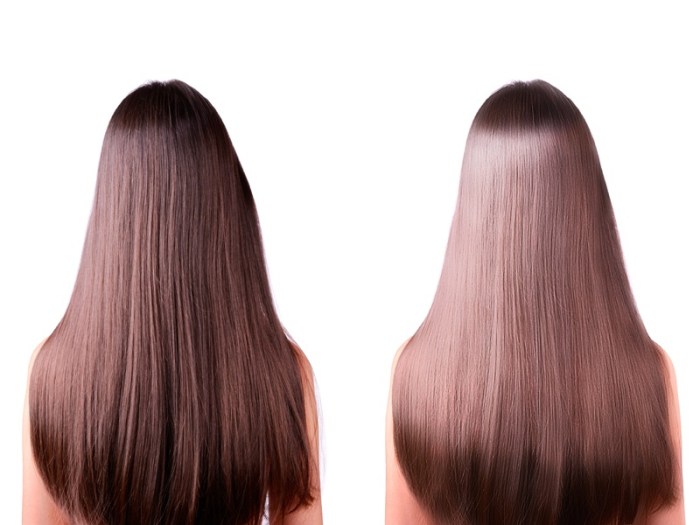
Chemical hair straightening is a process that uses chemicals to alter the structure of the hair, making it straighter and smoother. It is a popular hair treatment that can last for several months.Chemical hair straightening involves using a chemical solution to break down the bonds in the hair that give it its natural curl or wave.
Once the bonds are broken, the hair is straightened using a heat styling tool, such as a flat iron. The heat causes the new bonds to form, which hold the hair in its new, straightened position.
Types of Chemical Hair Straighteners
There are several different types of chemical hair straighteners available, each with its own unique benefits and drawbacks.
- Relaxers: Relaxers are the strongest type of chemical hair straightener. They contain a high concentration of chemicals, which can be harsh on the hair. However, they also produce the most dramatic results, and can last for up to six months.
- Smoothers: Smoothers are a milder type of chemical hair straightener. They contain a lower concentration of chemicals, and are less harsh on the hair. However, they also produce less dramatic results, and typically last for only a few weeks.
- Anti-frizz treatments: Anti-frizz treatments are designed to reduce frizz and make the hair more manageable. They typically contain a combination of chemicals and conditioning agents. Anti-frizz treatments do not straighten the hair, but they can make it appear smoother and straighter.
Comparison of Chemical Straightening Treatments
The results of chemical straightening treatments can vary depending on the type of hair, the texture of the hair, and the condition of the hair.
- Hair type: Chemical hair straightening is most effective on hair that is naturally curly or wavy. It is less effective on hair that is straight or fine.
- Hair texture: Chemical hair straightening is most effective on hair that is thick and coarse. It is less effective on hair that is thin and fine.
- Hair condition: Chemical hair straightening can damage hair that is already dry or damaged. It is important to condition the hair regularly before and after chemical hair straightening to keep it healthy.
Thermal Hair Straightening
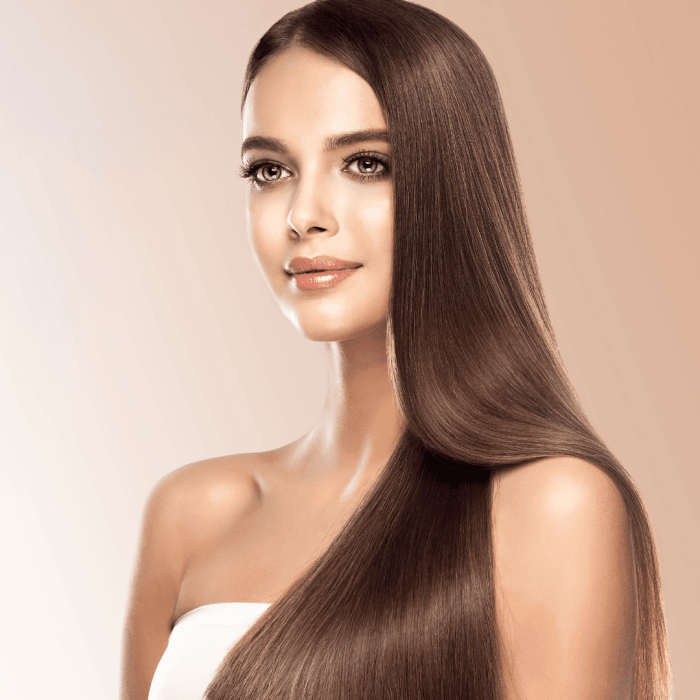
Thermal hair straightening utilizes heat to temporarily alter the structure of hair, resulting in straighter, smoother strands. This technique employs heated tools such as flat irons and curling wands to apply direct heat to the hair, causing the hydrogen bonds within the hair shaft to break and reform, resulting in a straighter configuration.
Achieving Optimal Results with Thermal Straightening
To achieve the best results with thermal straightening, it’s crucial to follow proper techniques and precautions:
- Heat Settings: Choose the appropriate heat setting for your hair type. Generally, finer hair requires lower heat settings, while thicker hair can withstand higher temperatures. Refer to the manufacturer’s instructions for specific guidelines.
- Hair Preparation: Before straightening, ensure your hair is clean, dry, and free of any styling products. Applying a heat protectant spray can help minimize heat damage.
- Sectioning: Divide your hair into manageable sections to ensure even heat distribution. Start with smaller sections for thicker hair and larger sections for finer hair.
- Technique: Glide the heated tool slowly and evenly through each section of hair, avoiding holding it in one spot for too long to prevent heat damage.
- Cooling: After straightening, allow your hair to cool completely before brushing or styling it further.
Potential Risks Associated with Thermal Straightening
While thermal hair straightening can provide temporary straightness, it’s important to be aware of the potential risks associated with excessive heat:
- Heat Damage: Excessive heat can damage the hair’s protein structure, leading to dryness, brittleness, and breakage. Over time, this can result in weakened hair that is more prone to split ends and breakage.
- Scalp Irritation: High heat can irritate the scalp, causing dryness, itching, and inflammation. In severe cases, it can even lead to scalp burns.
- Hair Loss: Prolonged or excessive use of heat styling tools can contribute to hair loss, especially if proper hair care practices are not followed.
To minimize these risks, it’s crucial to use thermal hair straightening tools sparingly and with proper technique. Additionally, regular deep conditioning treatments and avoiding excessive heat styling can help maintain healthy hair.
Mechanical Hair Straightening
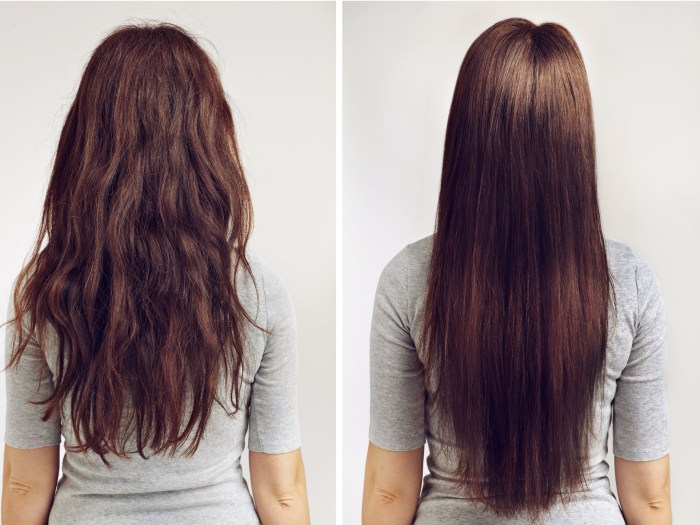
Mechanical hair straightening involves using tools like brushes and combs to physically align the hair strands, creating a smoother, straighter appearance. This method is often considered a temporary straightening solution, as the effects typically last until the next wash or until the hair is subjected to moisture or humidity.
Effectiveness of Mechanical Straightening Methods
The effectiveness of mechanical straightening methods can vary depending on the hair type and texture. For fine, straight hair, a simple brushing or combing may be sufficient to achieve a smooth, sleek look. However, for thicker, coarser, or curly hair, more intensive techniques, such as blow-drying with a round brush or using a straightening iron, may be necessary to achieve the desired results.
Advantages and Disadvantages of Mechanical Straightening
Mechanical hair straightening offers several advantages over chemical and thermal methods. It is a non-chemical process, which means it does not involve the use of harsh chemicals that can damage the hair. Additionally, it is generally less expensive and more accessible than other straightening methods.
However, mechanical straightening also has some disadvantages. The effects are temporary, and the hair may revert to its natural state after washing or exposure to moisture. Additionally, mechanical straightening can be time-consuming and may require a significant amount of effort, especially for thicker, coarser hair.
Deciding on Permanent Straightening

Permanent hair straightening can be a transformative decision, offering a low-maintenance and sleek look. However, it’s essential to carefully consider various factors before committing to this treatment.
Hair Health and Condition
The health of your hair plays a crucial role in determining the suitability of permanent straightening. Damaged, weak, or brittle hair may not withstand the chemical or heat processes involved in straightening, leading to further damage or breakage. A healthy hair foundation is essential for successful and long-lasting results.
Lifestyle and Maintenance
Permanent straightening requires a certain level of maintenance to upkeep the desired look. Regular touch-ups are necessary as new hair growth emerges, typically every 6-8 weeks. Additionally, specific hair care products and styling techniques may be required to maintain the straightened hair’s health and appearance.
Personal Preferences and Expectations
Ultimately, the decision to opt for permanent straightening should align with your personal preferences and expectations. Consider your desired level of straightness, the time and effort you’re willing to invest in maintenance, and your comfort level with the potential risks associated with chemical or heat treatments.
Table: Key Aspects of Permanent Straightening Treatments
| Treatment | Cost | Maintenance | Potential Risks |
|---|---|---|---|
| Chemical Straightening | Moderate to high | Regular touch-ups every 6-8 weeks | Hair damage, scalp irritation, allergic reactions |
| Thermal Straightening | Lower than chemical straightening | Frequent use of heat styling tools | Heat damage, dryness, split ends |
| Mechanical Straightening | Moderate to high | Less frequent touch-ups compared to chemical or thermal straightening | Hair breakage, scalp irritation, discomfort during treatment |
Hair Care After Straightening
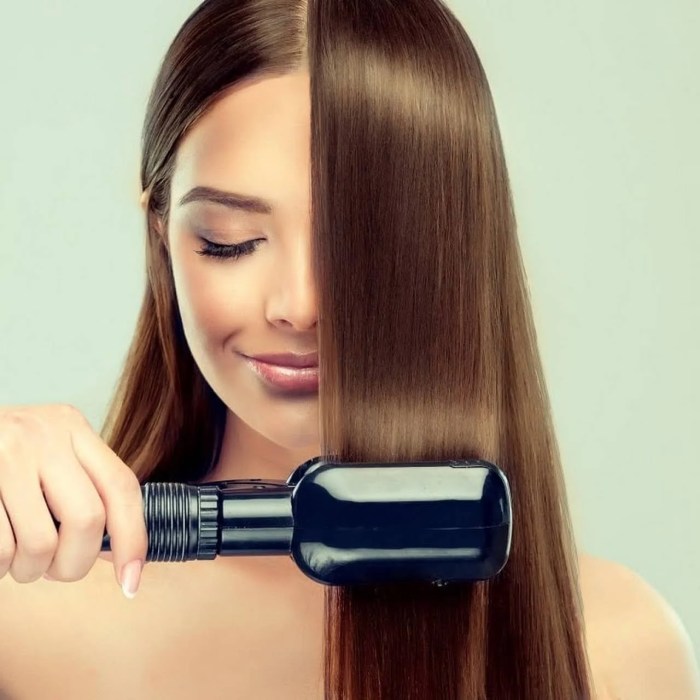
After undergoing a straightening treatment, it is crucial to take proper care of your hair to maintain its health and beauty. This includes using appropriate hair care products, avoiding harsh chemicals, and protecting straightened hair from environmental factors like sun exposure and humidity.
Choosing the Right Hair Care Products
Using the right hair care products is essential for maintaining healthy straightened hair. Look for products that are specifically designed for straightened hair, as they often contain ingredients that help to maintain the smoothness and prevent frizz. Avoid products that contain harsh chemicals, such as sulfates, parabens, and alcohol, as these can strip away natural oils and cause dryness and damage.
Protective Styling
Protective styling can help to protect straightened hair from environmental factors and reduce the need for frequent heat styling. Consider wearing your hair in braids, buns, or other protective styles to minimize exposure to sun, wind, and humidity. When using heat styling tools, always apply a heat protectant spray to help shield your hair from damage.
Regular Trims
Regular trims are important for maintaining healthy straightened hair. Split ends can cause frizz and breakage, so it is important to have them trimmed regularly to keep your hair looking its best. Aim to get a trim every 6-8 weeks to remove split ends and keep your hair healthy.
Avoid Harsh Chemicals
Harsh chemicals, such as those found in some hair dyes and styling products, can damage straightened hair. Avoid using products that contain harsh chemicals, such as bleach, ammonia, or peroxide. If you do need to use a product that contains harsh chemicals, be sure to follow the directions carefully and apply a deep conditioner afterwards to help repair any damage.
Safety and Precautions

When considering hair straightening treatments, it is crucial to prioritize safety and take necessary precautions to protect your hair and overall health. Understanding the potential risks and side effects associated with different straightening methods is essential to make informed decisions.
Regardless of the chosen method, always follow the instructions provided by the manufacturer or hairstylist. Improper application or overuse of products can lead to severe hair damage, scalp irritation, or allergic reactions.
Chemical Hair Straightening
Chemical hair straightening involves the use of chemical solutions that break down the hair’s natural bonds, allowing it to be reshaped into a straighter form. While effective, these treatments can be harsh on the hair, leading to potential side effects such as:
- Hair damage: Overuse or improper application of chemical straighteners can lead to dry, brittle, and weak hair prone to breakage.
- Scalp irritation: The chemicals used in straightening treatments can cause skin irritation, redness, and itching. In severe cases, chemical burns may occur.
- Allergic reactions: Some individuals may be allergic to the chemicals used in hair straighteners, leading to symptoms such as swelling, hives, and difficulty breathing.
Thermal Hair Straightening
Thermal hair straightening involves the use of heat styling tools, such as flat irons or curling wands, to reshape the hair into a straighter form. While generally considered less damaging than chemical treatments, thermal straightening can still cause hair damage if not used properly.
- Heat damage: Excessive heat can cause the hair’s protein structure to break down, leading to dry, brittle, and frizzy hair.
- Split ends: Overuse of heat styling tools can cause the hair’s ends to split and fray, making them more prone to breakage.
- Scalp burns: If the heat styling tool comes into contact with the scalp, it can cause burns and irritation.
Mechanical Hair Straightening
Mechanical hair straightening involves the use of physical force, such as brushing or combing, to straighten the hair. While generally considered the gentlest method, mechanical straightening can still cause hair damage if not done properly.
- Hair breakage: Rough brushing or combing can cause the hair to break, especially if it is wet or damaged.
- Split ends: Aggressive brushing or combing can also lead to split ends, making the hair more prone to breakage.
Final Conclusion
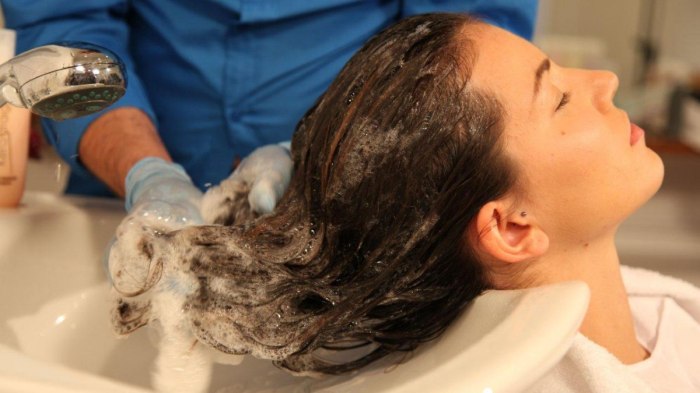
As you embark on your hair straightening journey, remember that knowledge is power. Understanding the different methods, their benefits, and potential risks will empower you to make choices that align with your hair’s needs and desires. Embrace the transformative power of hair straightening while prioritizing hair health and safety.
With the right approach, you can achieve the sleek, straight tresses you’ve always dreamed of, while maintaining the vitality and beauty of your hair.
FAQ Corner
Q: How do I choose the right hair straightening treatment for my hair type?
A: The ideal hair straightening treatment depends on your hair type, texture, and condition. Consult a hairstylist to assess your hair and recommend the most suitable method.
Q: Is permanent hair straightening damaging to my hair?
A: Permanent straightening treatments can cause some damage to your hair, especially if not done properly. However, with proper care and maintenance, you can minimize the risk of damage.
Q: How often should I get my hair straightened?
A: The frequency of hair straightening depends on the method used and the growth rate of your hair. Consult your hairstylist for personalized advice.
Q: Can I straighten my hair at home?
A: Some hair straightening methods can be done at home, but it’s important to follow the instructions carefully and use high-quality products to avoid damaging your hair.

